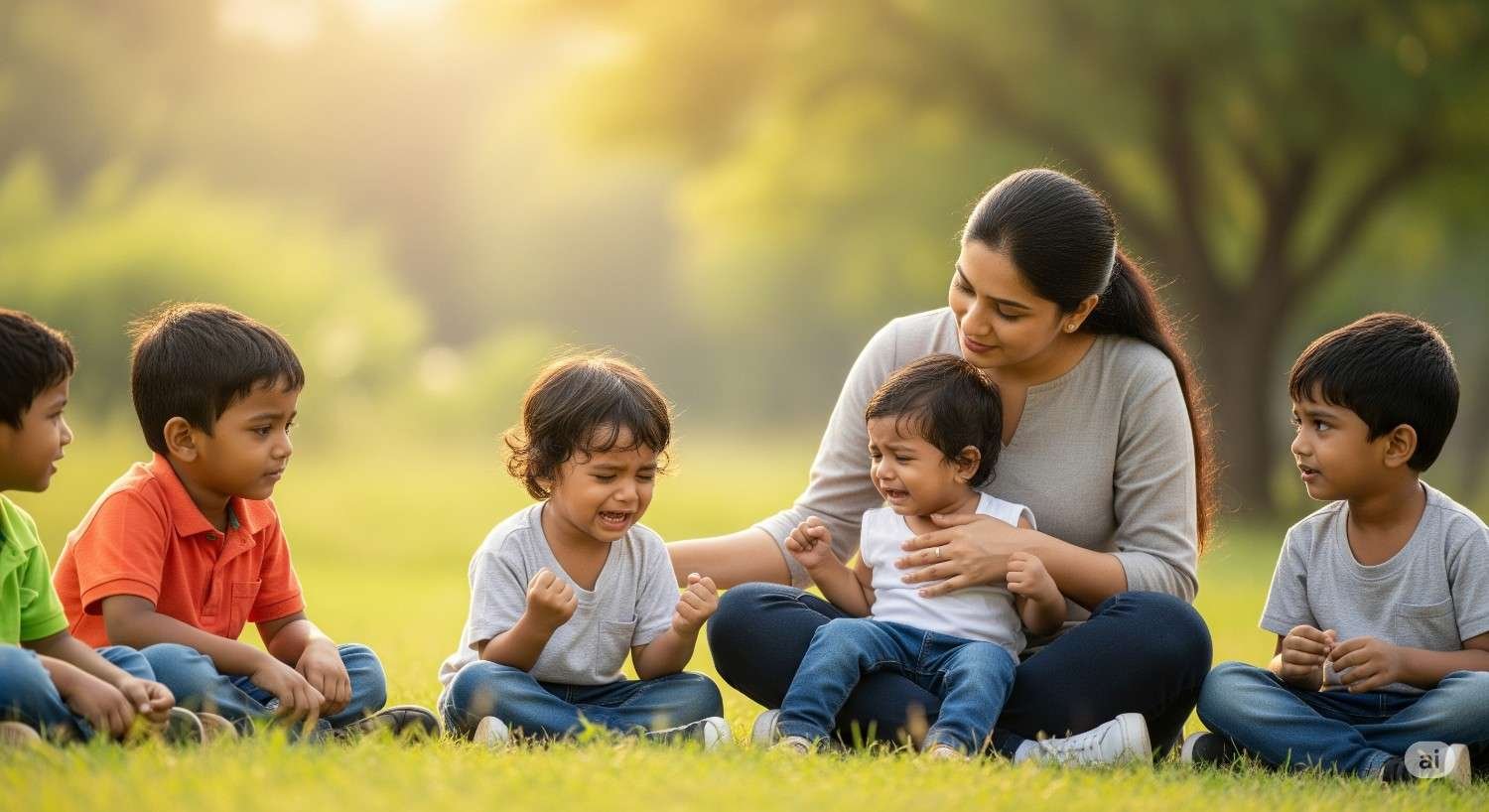
From Tantrums to Trust: Building Resilient Learners in Early Childhood Years
Welcome to Mom Educator’s Blog!
Let us step into the preschool world: Emotions in Action!
| Aarav | Meera |
|---|---|
| It is Monday morning. Aarav, a shy newly joined 4-year-old with big eyes and a smaller voice, clings tightly to his mother’s kurti. His new preschool is bright and cheerful, but to Aarav, it feels like another planet. | In the same classroom, we have Meera, queen of tantrums and toy-snatching who is already in action—snatching crayons, frowning furiously, and pushing chairs when things don’t go her way. |
Both children are perfectly normal. What they are missing is not discipline! Then what is it?
THEY ARE ACTUALLY MISSING EMOTIONAL INTELLIGENCE (EI)
What is emotional intelligence?
- Emotional Intelligence (EI) is not about being happy all the time.
- It is about being able to say, “I am sad,” “I am confused,” or “I need help”—and knowing how to handle those feelings.
- For preschoolers, it is as essential as learning ABCs and 1,2,3s.
- A child who understands their emotions is more likely to build friendships, manage frustration, and bounce back from setbacks.
- The best part of EI is that, it can be taught!
Tiny Tantrum, Big Realization
Let me introduce you to my 4.5-year-old son, Sam, who has become my tiny emotional intelligence guru. At age two, he was easily adaptable — he would eat anything, go anywhere, and did not mind who accompanied him. But by three, he started forming preferences: like wanting to listen to the same song, preferring a particular cup, plate or spoon for meals.
By four, these preferences became more structured — and intense. He would plan outings down to the vehicle type (“Not two-wheeler, Mumma! Only car!”) and the agenda (“No relatives. Only toy shop!”). Any deviation from the plan resulted in visible emotional outbursts. Once, an Amazon toy delivery was cancelled — a toy helicopter he had waited for two whole days. When it did not arrive, Sam broke down in tears, unable to understand why the promise was broken.
That moment made me reflect — not on his behaviour, but mine!
Children at this age struggle with delayed gratification. Emotional reactions are often linked to tangible rewards like toys or sweets. And yes, they often learn from what they see. Perhaps Sam had observed me arguing, raising my voice, or expressing stress in urgency. May be, he simply may have mirrored it.
What is happening in their little mind?
Between ages 3–6, kids are in Erik Erikson’s “Initiative vs. Guilt” stage. They want to explore, experiment, and take charge—but they need loving guidance to succeed.
Cognitively, they are in Piaget’s Preoperational Stage, where imagination rules, and empathy is just beginning to form. That is why teaching feelings during this time is powerful—they are soaking it all in.
And as Bandura’s Social Learning Theory reminds us: children learn what they see. If we yell, they will yell. If we take a deep breath and name our emotions, so will they.
Building blocks of emotional intelligence in early childhood education
| Building Block | What It Means | Age | Tips for Teachers |
|---|---|---|---|
| 1. Emotional Awareness | Knowing and naming feelings | 3–4 yrs | Use emotion cards, model feelings |
| 2. Social Skills | Playing and talking nicely | 3–6 yrs | Conduct group games, teach friendly words |
| 3. Self-Regulation | Managing big emotions | 4–5 yrs | Teach deep breathing, keep routines |
| 4. Empathy | Understanding others’ feelings | 4–5 yrs | Conduct role-plays, talk about story characters |
| 5. Motivation | Trying and finishing tasks | 5–6 yrs | Set goals, cheer small wins |
How to Develop Resilient Learners: 5 Key Techniques
1. Model Emotional Intelligence
Children learn by watching adults. When parents and teachers show calmness, empathy, and respectful communication, children mirror the same.
- 👦 Funny moment: Sam observed his loud family dinner and reminded everyone, “Say please! Like I do in school!”
- 💡 Takeaway: Be the emotional model you want your child to follow.
2. Storytelling and Role Play
Use stories and pretend play to help children explore emotions. Let them describe how characters feel and why — this builds empathy and emotional vocabulary.
- 💡Takeaway: Stories and pretend play turn feelings into words and build empathy through imagination.
3. Encourage Reflective Thinking
When Sam’s playdate was cancelled, he cried. Instead of ignoring his feelings, his mom gently asked, “How are you feeling now?” Sam said, “I am sad Papa did not come early and take me to the play-area.” Naming emotions helped him calm down.
- 💡 Takeaway: Give space to talk about feelings — reflection builds emotional understanding.
4. Create a Positive & Consistent Culture
Children need predictability. When a planned clay activity was cancelled in the class without notice, students got upset. They were not involved in the drawing activity. A simple explanation and rescheduling could have preserved the trust and mood.
- 💡 Takeaway: Consistency and clear communication creates emotional safety.
5. Practice Mindfulness
Simple routines like deep breathing, emotion check-ins, and quiet corners helped Riya, 5, manage her emotional outbursts. She learned to pause, process and respond instead of reacting directly.
- 💡 Takeaway: Just a few mindful minutes a day can improve emotional control.
At Birla Open Minds, we have introduced the Soul Science curriculum, a unique initiative that nurtures emotional intelligence in young learners while also instilling the value of SEVA—selfless service to the community. This holistic approach helps children grow, not just academically, but emotionally and socially.

